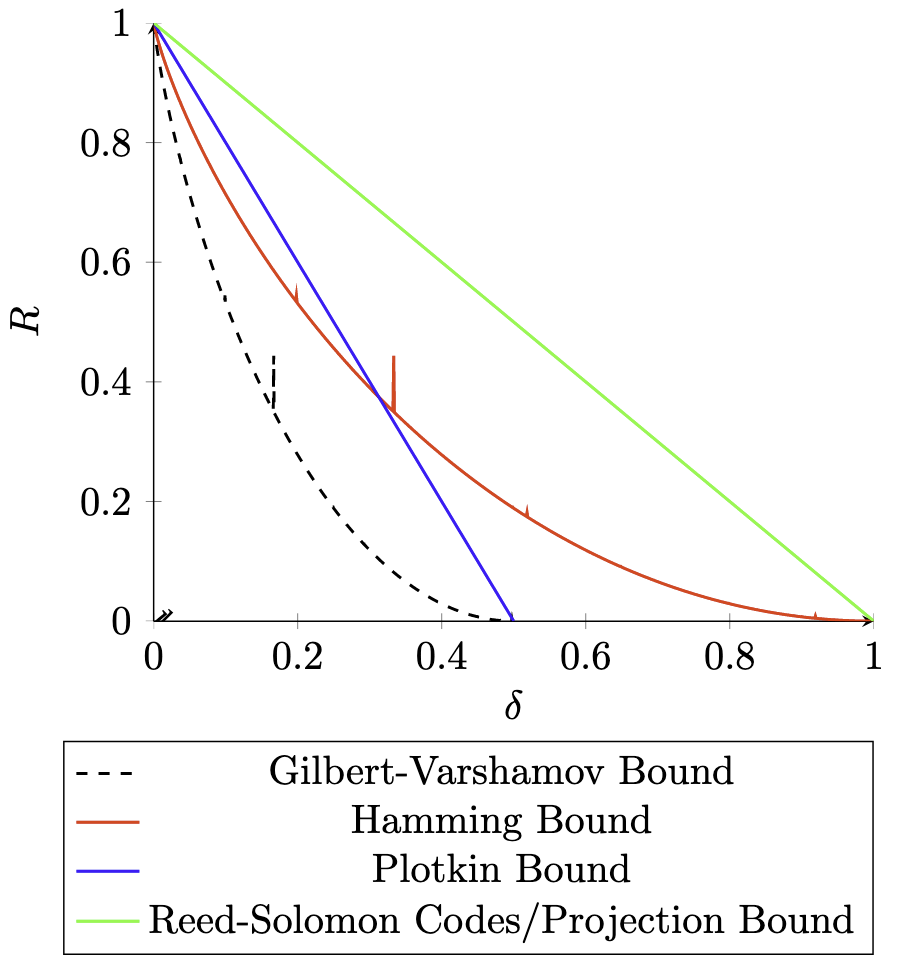After a long “travel” in coding theory, I finally feel I have understand the Bound. So I come back to write down this blog in case I forget again in the future
In this blog, we will introduce some bounds used in coding theory.
Hamming Bound
Fact 1 Let $C$ be a code with minimum distance $d$. For any $c, c^{\prime} \in C, c \neq c^{\prime}$, we have that $B\left(c,\left\lfloor\frac{d-1}{2}\right\rfloor\right)$ is disjoint from $B\left(c^{\prime},\left\lfloor\frac{d-1}{2}\right\rfloor\right)$.
For Binary Code:
Set $r=\left\lfloor\frac{d-1}{2}\right\rfloor$ .It follows from Fact 1 that
Also
and so we have
which gives us
Thus,
Similarly, For q-ary case:
As we all know, the correctable codeword must contain no more than $\lfloor(d-1) / 2\rfloor$ errors. So if we want every codeword to be correctable, the ball must be disjoint
Gilbert–Varshamov bound
In my understanding, we can regard GV bound as a greedy approach to construct code.
For Binary Code:
- Set $S=\{0,1\}^n$ and let $C=\emptyset$.
- As long as $S \neq \emptyset$, pick a point $v \in S$ and add $v$ to $C$. Remove $B(v, d-1)$ from $S$, i.e. $S=S \backslash B(v, d-1)$.
Notice that we are removing at most $\sum_{i=0}^{d-1}\binom{n}{i}$ points from $S$ in every iteration. Since we add one element to $C$ in each iteration, we have that
Similarly, For q-ary case:
This is a constructive proof, so
Plotkin Bound
Plotkin Bound answer the question that
The proof proceeds by shortening the codewords. We group the codewords so that they agree on the first $n-n^{\prime}$ places, where $n^{\prime}=\left\lfloor\frac{q d}{q-1}\right\rfloor-1$. In particular, for any $x \in[q]^{n-n^{\prime}}$, define
Define $d=\delta n$. For all $x, C_x$ has distance $d$ as $C$ has distance $d .{ }^1$ Additionally, it has block length $n^{\prime}<\left(\frac{q}{q-1}\right) d$ and thus, $d>\left(1-\frac{1}{q}\right) n^{\prime}$. By sphere-packing bound,
this implies that
where the second inequality follows from the facts that $d>(1-1 / q) n^{\prime}$ and that $q d-(q-1) n^{\prime}$ is an integer.
Note that by the definition of $C_x$ :
which by (1) implies that
In other words, $R \leq 1-\left(\frac{q}{q-1}\right) \delta+o(1)$ as desired.
For binary case, we have $R+2\delta \leq 1$
Singleton Bound
Delete last $\delta n-1$ coordinates of all codewords in $\mathcal{C}$. All remaining codewords are distinct (as otherwise two identified codewords would have had distance $\delta n-1<\delta n$ ). Further all remaining shortened codewords lie in $\Sigma^{(1-\delta) n+1}$. Therefore $|\mathcal{C}| \leq|\Sigma|^{(1-\delta) n+1}$. So we directly have that the rate is $R \leq 1-\delta+\frac{1}{n}$.
It looks like Singleton Bound above the Plotkin bound. This is possible beacause $R+2\delta \leq 1$ only for binary case
